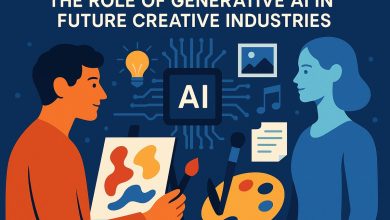
The ABBYY AI Summit 2025 wasn’t just another tech conference. Held inside Arsenal’s iconic Emirates Stadium, the event brought together AI experts, business leaders, and practitioners with a singular focus: how AI can move from buzzword to business benefit.
But the real question wasn’t what the future holds. It was what you could do with it today.
Whether you’re a CIO, an operations lead, or simply responsible for transforming manual work into intelligent systems, the lessons from this summit offered practical insight. Insight that anyone implementing AI and automation can take action on.
Purpose-Built AI Over General Hype
The opening keynote by ABBYY CEO Ulf Persson set the tone: AI that adds value is built with purpose.
Rather than chasing the hype of generative models, ABBYY emphasised the power of targeted, domain-specific tools like Document AI and Process AI. These solutions are already helping customers achieve 95% straight-through processing, 400% productivity increases, and 30% faster business decisions.
So what does that mean for you and your team solving problems?
It means you don’t have to start with moonshot projects, trying to change everything at once. You can begin with the documents and information you have sitting there waiting to be understood.
Ask yourself: where do repetitive document-based tasks slow things down or create risk in your business? That’s where Document AI can help. Think about it, how many times have you been given a document by a colleague, cc’d in on an email thread, saved something several years ago never to use it again. That is all information waiting to be used.
ABBYY’s approach shows that meaningful gains come from systems that know your domain and can work seamlessly within it. These are tools that don’t hallucinate. They extract, classify, route, and act. All reliable in the ABBYY platform.
As Ulf put it in our interview, “The magic isn’t just in recognising a document. It’s in knowing what to do with the data inside it — and doing it automatically, end to end.”
Automation That Pays for Itself Over, and Over, and Over Again.
One of the biggest audience reactions came during the session with Jon Knisley from ABBYY, who shared a startling stat: 40% of AI investment is wasted due to broken or inefficient processes. Nearly half of what’s spent on AI delivers no return, not because the tech isn’t good, but because the workflows underneath it are flawed.
That’s a great example we were shown on where Process AI can deliver measurable results. Especially in the setting of an enterprise.
It’s not just about automating a task. It’s about understanding how the task fits into the broader system. And how those systems can be orchestrated intelligently.
This idea came to life in a session with Lloyds Banking Group, an ABBYY customer, where Head of Intelligent Automation Huw Jones shared how they combine expert models, RPA, and APIs under a single orchestrator to enable agentic automation. It’s not about one tool winning. It’s about getting the right combination to deliver the result.
If you’re considering automation in your own business, ask:
-
Where do handoffs break down?
-
What steps are still manual but could be rules-based?
-
Are you optimising the workflow, or just speeding up a flawed one?
AI That Works in the Real World
The most refreshing part of the summit? A clear rejection of “AI theatre.”
That means no overpromising, no black-box mystery, and no hallucinated answers.
ABBYY’s Head of AI, Maxime Vermeir, shared how they avoid unreliable outputs by steering clear of purely generative models for document handling. Instead, they focus on deterministic, production-grade tools designed to work in regulated enterprise environments.
“We’re not interested in cool demos that fall apart at scale,” Maxime said. “We’re building tools that help real people do real work. That means no surprises, no shortcuts — just trustworthy automation.”
This philosophy also extends to integration. One of the biggest friction points in enterprise AI is legacy systems. Maxime was candid about that challenge, but explained how ABBYY’s platform works with what customers already have, rather than requiring a rip-and-replace.
For businesses that feel stuck behind outdated tools, that message matters. And that’s a great way to lean into what Maxime and Ulf explained to me about the ABBYY university.
Skills and Scale: Why ABBYY University Matters
A major announcement at the event was the milestone of over 18,000 graduates from ABBYY University — their dedicated training platform for AI-powered automation and intelligent document processing (IDP).
It’s a key part of what makes ABBYY’s tools work in the real world: they’re skilling up both customers and partners, fast. Whether it’s IT teams learning to deploy automation solutions, or business analysts learning how to configure workflows, the platform bridges the gap between tech and outcome.
Want to build AI into your business but struggling with team capability?
The way I personally interpreted what Ulf and Maxime said was to start with education at every level in order to answer this question. Always be constantly learning, understanding the challenges, how to adapt, what to do better, ways to make a process simpler and faster. Train the people closest to the work they are doing on a regular daily basis. That way the team feels more engaged and the customer feels more listened to, making it much easier to have great communication on when things do inevitably go wrong.
Build for the Future, Respect the Rules
Throughout the day, a theme came up again and again: AI governance isn’t just a compliance checkbox — it’s a trust enabler.
ABBYY is one of the first companies to operationalise AI risk management aligned with the EU AI Act. That means clear frameworks for explainability, consent, and data protection.
But it also means something more fundamental. Which is building for the right reasons on all fronts, the customer, the team, the partner ecosystem, and the wider use cases of that business.
As Ulf said, “We don’t build for compliance because we have to. We build for it because it’s the right thing to do.”
That mindset echoed across multiple sessions. From synthetic data to upstream decision-making, ABBYY’s speakers reminded the audience: If you want AI to be sustainable in your business, you need to be deliberate about how it makes decisions — and who gets to influence them.
The Real Takeaway: AI That Works, Without the Drama
The ABBYY AI Summit wasn’t about sci-fi futures. It was about operational reality.
It was about agentic automation that respects regulation.
About document intelligence that eliminates bottlenecks.
And about building systems that people can trust, and actually use.
So what can you take away?
-
Start small, think big. Automate one document process, then scale.
-
Fix your processes before you plug in AI. Don’t optimise chaos.
-
Train your people. Tools only work when the team does.
-
Treat compliance as a design principle, not a blocker.
-
Use AI to reduce friction, not add flash.
The future of AI isn’t about more complexity. It’s about clarity. ABBYY seems to be leaning into that with confidence — and helping its customers do the same.



